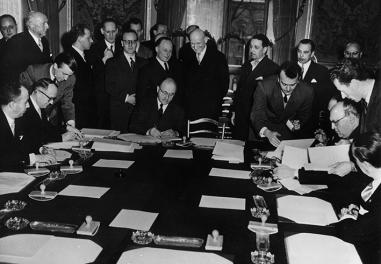Creation of the UN
Seventy years ago, on 26 June 1945, the United Nations Charter was signed in San Francisco. This founding text of the new international institution joined by 51 countries was designed to ensure world peace and security after World War II.

Constituent instrument of the United Nations, the Charter was the result of a long process whose main lines had already been laid down before the end of the war, in October 1944. It was adopted on 26 June 1945 by 50 Signatory States (Poland signed later but is nonetheless considered one of the original Member States) and came into force on 24 October 1945. The Charter's preamble bears witness to the immense hope that the nations brought to this new international instrument: "We the peoples of the United Nations determined to save succeeding generations from the scourge of war, which twice in our lifetime has brought untold sorrow to mankind, and to reaffirm faith in fundamental human rights, in the dignity and worth of the human person, in the equal rights of men and women and of nations large and small, and to establish conditions under which justice and respect for the obligations arising from treaties and other sources of international law can be maintained, and to promote social progress and better standards of life in larger freedom [...] have resolved to combine our efforts to accomplish these aims [...]".
Such an ambitious project could not help but bring out many differences of opinion, especially as the Charter defined a new world order based on a hierarchy left by the war. Thus, promoting the deployment of a global system of conflict resolution called into question the regional organisations that had nonetheless produced stability in wide areas of the globe. As they could not simply be absorbed, they were confirmed in their roles (article 52 of the Charter) and were given observer status on condition that their goals were in compliance with those of the United Nations. Likewise, setting up an International Court of Justice (ICJ, article 92) was not unanimously approved and, in the end, it was decided that the member countries would not be required to recognise its jurisdiction. Thus, the ICJ's judicial activity depends on the consent of the States, which considerably limits its power to act. But, despite the democratic principal of "one country, one voice" observed at both the General Assembly and the Security Council, it was notably the question of the veto right granted to the five permanent members of the Security Council (United Kingdom, United States, Soviet Union, China and France) that gave rise to the most intense discussions. Many people saw this provision as being the expression of an arbitrary privilege contrary to the very spirit of the Charter's preamble. By imposing this provision, even making it the cornerstone of the new organisation, the "Big Five" presented themselves as being humanity's new leaders. This legitimacy was based on the principal of responsibility and on the reality left by the war. But it was questionable, as the other countries could fear that the system was just shaped to protect the interests of the "Big Guys". The Cold War logic that took hold starting in 1947, then the Korean War, were soon to bring out some of this organisation's limits, which are still being debated today, especially as the lines of force in 1945 were not those of today's world.
Today, the United Nations has 193 Member States out of the 197 States recognised. Maintaining international peace and security, guaranteeing international law, forbidding the use of force and requiring the peaceful resolution of conflicts, promoting sustainable development, providing humanitarian aid and protecting Human Rights, these are the principals and missions laid down by the United Nations Charter. For seventy years, the UN has had a military intervention force, the "Blue Helmets", and has worked in favour of peace everywhere around the world. While the American President Harry Truman, in his closing speech in 1945, promised, "victory against war itself...", much remains to be done.
Read more
www.un.org/fr
Bibliography :
French forces with UNTAC in Cambodia, May 1992-December 1993
French forces in the Bosnia War
Photo galleries :
1982: the French army in Lebanon through photographs by reporter François-Xavier Roch
Terrorist attack at the "Drakkar" post in Lebanon, 23 October 1983
UNTAC (United Nations Transitional Authority in Cambodia) in Cambodia, May 1992-December 1993
French blue helmets in Cambodia with UNTAC
French and Canadian protection forces with the UNPROFOR in Sarajevo
French and American humanitarian aid in Somalia: Operations "Oryx" and "Restore Hope"
Operation "Libage": humanitarian aid to Kurdish populations
Operations Amaryllis and Turquoise in Rwanda (April-September 1994)
French and foreign military activities of the KFOR in the summer of 2000
Reporters in Afghanistan – 2009 Part 1-Part 2
Support for emergency humanitarian aid in Nepal
Vidéos :
De Sarajevo à Kigali : deux années d'interventions extérieures de l'armée française de fin 1992 à fin 1994. Part 1-Part 2-Part 3
Articles of the review
-
The file

After the war, what next for Europe?
Once the guns had fallen silent, people had to learn how to live in peace again. International conferences were organised to establish a new global balance, but by 1947 Europe had been divided into two zones of influence. In the West, a group of politicians motivated by the same ideal nonetheless be...Read more -
The event

April 1948-September 1951: the Marshall Plan
Read more -
The interview
Mauve Carbonell
Doctor of History, researcher at ESPE Aix-Marseille and member of the teaching team at the Master of European Studies at Aix-Marseille University, Mauve Carbonell talks about the reasons that led to the resurrection of the European idea after World War II.
Read more

